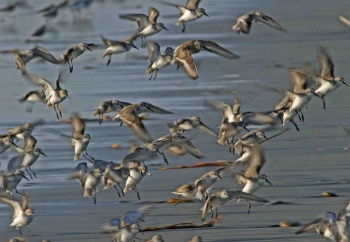(Breeding & flight pictures. Some copied text cleaned up. References) |
(OBI link removed) |
||
| Line 26: | Line 26: | ||
==External Links== | ==External Links== | ||
{{GSearch|Calidris+mauri}} | {{GSearch|Calidris+mauri}} | ||
| − | + | ||
[[Category:Birds]] [[Category:Calidris]] | [[Category:Birds]] [[Category:Calidris]] | ||
Revision as of 23:03, 24 March 2010
- Calidris mauri
Identification
Dark legs that has partially webbed toes (similarly much as Semipalmated Sandpiper, short thin dark bill, thinner at the tip with a kink that gives an impression of a downturned bill. Most birds have longer bills than Semipalmated Sandpiper but there is much overlap.
Breeding: pale basic color with many dark spots on underside and mantle, scapulars reddish-brown with black centers, reddish brown crown and ear-coverts. Semipalmated Sandpiper can also have reddish-brown but not as much as a fully marked western.
Winter: mostly pale grey upperside, white underside with whitish breast area. Semipalmated Sandpiper has darker ear-coverts and upper breast
Juvenile: rufous on upper scapulars producing a contrasting V on the back, pale breast and side and underside of head.
Distribution
Breeds in eastern Siberia and Alaska. Migrates on both coasts of North America, far more common on the west coast where 4 million can be found in one area.
Winters in South America.
Taxonomy
This is a monotypic species[1].
Habitat
Tundra, wetlands and mudflats.
Behaviour
Breeding
They nest in scrapes on the ground usually under some vegetation. The female selects one of several scrapes prepared by the male. The clutch consists of 4 eggs which are incubated by both adults. The female often leaves before the young have fully fledged.
Diet
The diet includes insects, small crustaceans and molluscs.
References
- Clements, JF. 2009. The Clements Checklist of Birds of the World. 6th ed., with updates to December 2009. Ithaca: Cornell Univ. Press. ISBN 978-0801445019.
- Wikipedia
Recommended Citation
- BirdForum Opus contributors. (2024) Western Sandpiper. In: BirdForum, the forum for wild birds and birding. Retrieved 3 May 2024 from https://www.birdforum.net/opus/Western_Sandpiper






